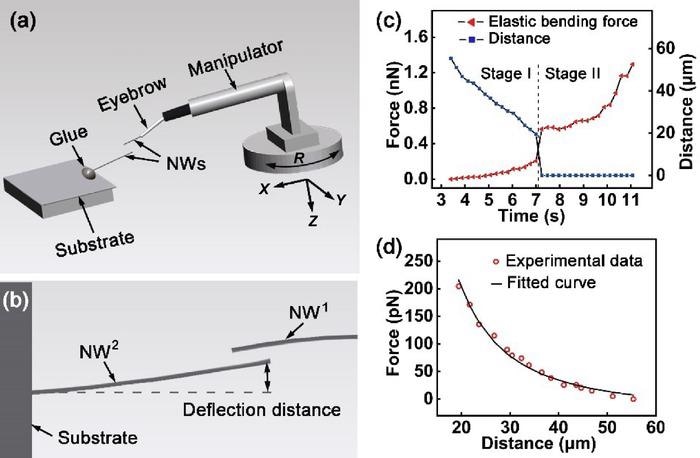Nanowires, which find their use in transistors, sensors, optoelectronic devices and other systems that need subatomic preciseness, like to stick together.
 Researchers reveal why nanowires stick to each other. Image Credit: Nano Research
Researchers reveal why nanowires stick to each other. Image Credit: Nano Research
Untangling electrical wires could be a complicated process — imagine trying to isolate wires 1/1000 the width of a human hair. The self-attraction of nanowires has been considered a major issue for quality and well-organized bulk fabrication. This can catastrophically short-circuit nanowire-based devices. Scientists in China have currently disclosed why the components stick to one another.
The study was published on December 27th, 2021, in the Nano Research journal.
Electrostatic force, capillary force or van der Waals force has all been considered as driver of self-attraction in nanowires, but the cause remained debatable due to experimental challenges.
Dr. Junfeng Cui, Study First Author, Key Laboratory for Precision and Non-Traditional Machining Technology of Ministry of Education, Dalian University of Technology
Nanowires attract each other in the air, but they are too small to be completely analyzed without microscopic inspection. Normally, nanowires are imaged with the help of an electron microscope, which employs a beam of electrons to visualize specifically small subjects — a variable that is hard to correct in a material that is sensitive to electrons, like the nanowires.
It is a catch-22: the scientists need the microscope to note the behavior of the wires, but the microscope alters their behavior. Hence, the scientists took a step back to the basics and applied an optical microscope. While the optical microscope does not disclose nearly as much detail as an electron microscope, it makes use of visible light that does not intervene with the nanowires.
Further, researchers made use of a moveable manipulator holding a human eyebrow hair to employ glue to a nanowire and affix it to a substrate. The remaining glue was utilized to fix another nanowire to the eyebrow hair. Both nanowires were brought into the center point in the optical microscope.
We were able to measure the distance between two individual nanowires and related attractive force in real time. The two nanowires attached to each other instantaneously when they were close enough, which can be attributed to the electrostatic force.
Dr. Junfeng Cui, Study First Author, Key Laboratory for Precision and Non-Traditional Machining Technology of Ministry of Education, Dalian University of Technology
Cui states that they found out the attractive force by studying how the nanowire diverted from its stationary position
Similar to a plastic wrap sticking to a person’s hand, the differently charged electrons present in the two nanowires increased as their distance decreased, snapping to each other at near range. Also, similar to a plastic wrap, it takes some force to isolate them again — van der Waals force, to be accurate.
A weak interaction happens between atoms next to each other, the van der Waals force could be broken easily by exerting powerful mechanical force to isolate the materials.
Providing a safe distance is the key to avoid nanowires bunching up together and possibly short circuiting leading to disastrous accidents, especially the fields of aerospace and nuclear energy—but, on the other hand, nanowire self-attraction has great potential in such applications as nanotweezers or nanoelectromechanical switches.
Dr. Junfeng Cui, Study First Author, Key Laboratory for Precision and Non-Traditional Machining Technology of Ministry of Education, Dalian University of Technology
Cui added, “Understanding the self-attraction of nanowires is key to fabricating high-quality nanowires and developing high-performance nanowire-based devices. Our versatile method to identify and measure nanowire self-attraction revealed that the attraction behavior of nanowires can be controlled, as we hoped.”
Cui is also affiliated with the Key Laboratory of Marine Materials and Related Technologies, Ningbo Institute of Materials Technology and Engineering, Chinese Academy of Sciences (CAS).
The other contributors of the study include Zhenyu Zhang, Key Laboratory for Precision and Non-Traditional Machining Technology of Ministry of Education, Dalian University of Technology; Le Lv, Guoxin Chen and Nan Jiang, Key Laboratory of Marine Materials and Related Technologies, Ningbo Institute of Materials Technology and Engineering, CAS; and Kazuhito Nishimura, Advanced Nano-Processing Engineering Lab, Mechanical Engineering, Kogakuin University.
Journal Reference:
Cui, J., et al. (2022) Quantitatively investigating the self-attraction of nanowires. Nano Research. doi.org/10.1007/s12274-021-4051-2.
Source: http://www.tup.tsinghua.edu.cn/en/index.html